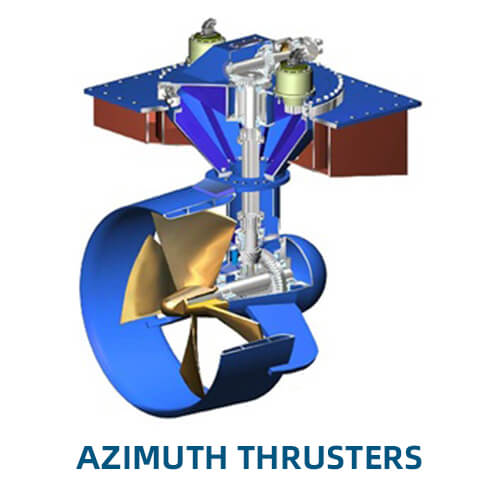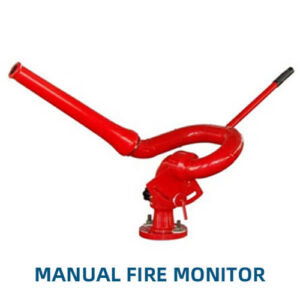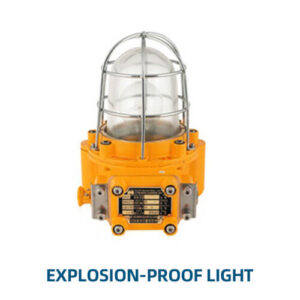Key Features of Azimuth Thrusters:
- Design and Construction:
- Rotatable Housing: The key feature of azimuth thrusters is their ability to rotate the entire thruster assembly 360 degrees. This rotation allows the propeller to direct thrust in any horizontal direction.
- Propeller: The thruster is equipped with a propeller housed within a rotating pod or gondola. The propeller is designed to provide thrust in the desired direction based on the orientation of the thruster.
- Drive System: Azimuth thrusters are powered by electric or hydraulic motors. The drive system is integrated into the thruster assembly, providing power to the propeller and enabling rotation.
- Types of Azimuth Thrusters:
- Conventional Azimuth Thrusters: These thrusters have a fixed gearbox and use mechanical means to transmit power from the motor to the propeller. They provide robust performance and reliability.
- Electric Azimuth Thrusters: Equipped with electric motors, these thrusters offer efficient power transmission and can be integrated with advanced control systems for precise maneuverability.
- Hydraulic Azimuth Thrusters: Powered by hydraulic systems, these thrusters are often used in larger vessels or applications where hydraulic power is preferred for its robustness and control.
- Podded Azimuth Thrusters: These thrusters are integrated into the vessel’s hull with a streamlined pod design, reducing drag and improving overall efficiency. They are commonly used in modern vessels.
- Applications:
- Marine Vessels: Azimuth thrusters are used in various types of marine vessels, including tugboats, cruise ships, ferries, and offshore support vessels. They enhance maneuverability and operational efficiency.
- Offshore Platforms: In offshore operations, azimuth thrusters are used to maintain the position of drilling rigs and floating platforms, providing stability and precise positioning.
- Dynamic Positioning Systems: Azimuth thrusters are integral to dynamic positioning systems used in offshore and scientific research vessels, where maintaining a precise location is crucial.
- Performance Characteristics:
- Maneuverability: Azimuth thrusters provide excellent maneuverability, allowing vessels to move in any direction without changing the vessel’s orientation. This capability is particularly useful in tight spaces and complex docking scenarios.
- Dynamic Positioning: The 360-degree rotation of azimuth thrusters allows for precise control and positioning, essential for operations requiring stable positioning in open water or dynamic environments.
- Efficiency: Modern azimuth thrusters are designed for high efficiency, with improved hydrodynamic profiles that reduce drag and enhance fuel economy.
- Maintenance and Care:
- Regular Inspection: Inspect azimuth thrusters regularly for signs of wear, damage, or corrosion. Check the rotating mechanism, propeller, and drive system for proper function.
- Cleaning: Keep the thruster assembly clean to remove marine growth and debris that can affect performance and efficiency.
- Lubrication: Ensure that moving parts, such as bearings and gears, are properly lubricated to maintain smooth operation and prevent wear.
- Safety Considerations:
- Proper Training: Crew members should be trained in the operation and maintenance of azimuth thrusters to ensure safe and effective use.
- Load Limits: Adhere to the recommended load limits and operational guidelines to prevent overloading and potential damage.
- Emergency Procedures: Familiarize the crew with emergency procedures in case of thruster malfunction or failure.
Advantages of Azimuth Thrusters:
- Enhanced Maneuverability: Provides superior control and maneuverability, allowing vessels to operate efficiently in confined spaces and complex docking situations.
- Precise Positioning: Ideal for dynamic positioning and operations requiring accurate location control.
- Reduced Need for Rudders: Eliminates the need for traditional rudders, simplifying the vessel’s design and improving overall efficiency.
Considerations for Azimuth Thrusters:
- Cost: Azimuth thrusters can be expensive, both in terms of initial investment and maintenance. However, their benefits in maneuverability and efficiency often justify the cost.
- Maintenance: Regular maintenance is essential to ensure the thruster remains in good working condition and performs optimally.
Azimuth thrusters are vital components for modern marine vessels, providing enhanced maneuverability, control, and efficiency. Their ability to rotate 360 degrees allows for precise directional control, making them essential for a wide range of marine and offshore operations.








